Hello fellow lovers of all things green,
As I write, to my delight, it’s the morning after a porch camp. Our run of excessive heat and humidity has dampened enthusiasm for sleeping on the futon on the screen porch in recent weeks. I adore the sounds of nature during each camp and the sights of early morning. I sleep out there in the winter too, when the temperatures are above 45 degrees, although I’ve woken up to temps as low as 38 degrees, taken by surprise. But that’s what blankets, sweatpants, and sweatshirts are for. (Funny, they call them that, aren’t they supposed to keep you warm rather than make you sweat?)
Green Frogs Lulled Me to Sleep
Last night, the calls of green frogs lulled me to sleep. The critters in the pond next to the porch sing, and then their friends in the overflow pond by Johnsonburg Creek answer back. Each echoes the same number of syllables with sounds described as a banjo being plucked, dropping a bit in volume and pitch from beginning to end: GUNK! – Gunk! – gunk! While most often, there are three syllables, there can be one or two. Their chorus went on intermittently, or maybe I slept through some of the chorus. In the middle of the night, there was a single croak of a frog in the pond next to me, and then one answered back from the pond near the creek. Then two croaks, his friend’s answer is a perfect echo.
Many times I’ve tried to photograph the green frogs, but as soon as you get near them, they make a loud yelp and jump quickly into the pond. Lang Elliot’s website MusicOfNature.com describes it as “An abrupt iCUP! I am grateful to my friend Blaine Rothauser for sharing these stunning photos.
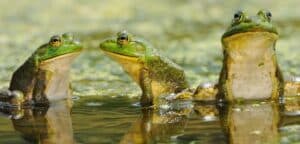
“Three Amigos” (Green Frogs) photo by Blaine Rothauser
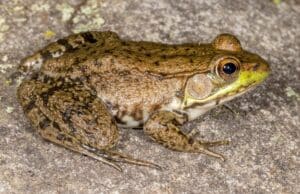
Green Frog (Lithobates clamitans) Photo By: Blaine-Rothauser
Green frogs (Lithobates clamitans) consume a variety of garden pests, including slugs, grubs, and mosquitoes, and I adore them as I do all frogs and toads.
The great horned owls then chimed in— hoo, hoo-hoo, hoo, hoo—the second and third hoots are shorter than the others. One was nearby, the other at a distance. When you hear two great horned owls hooting at night (Bubo virginianus), they’re communicating with each other to establish their territory and warn other owls to stay away. It’s also a mating call during the mating season (January to early February) here in Northern New Jersey.
Great Horned Owls Chime In
I’m grateful to know they are still living here. Last year, they nested in a dead tree just beyond the footbridge over the upper pond. During an overnight storm, the tree fell. The next morning, there was an egg cracked below the tree with a partially formed baby owl inside. It broke my heart.
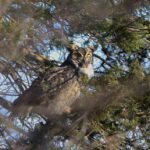
Great Horned Owl photo by Blaine Rothauser
Only when they’re young do great-horned Owls have predators, such as foxes and coyotes, so they are the king of the forest among birds. Like hawks, the benefit of having owls is feasting on small rodents that impact our gardens. They also prey on larger mammals, such as woodchucks, porcupines, and skunks, as well as large birds, including geese, ducks, and hawks. Sadly, they’ll also snag a house cat or small dog. While they usually hunt at night, they sometimes do so during the day, so be vigilant when watching over your pets.
Great horned owls typically mate for life and stay in their territories year-round. One evening, during the last call with Jolee, I turned on the flashlight while crossing the footbridge and saw the great owl take flight. The shadows from the lights made the owl look larger than it is, although it can be up to about 25 inches in length with a 57-inch wingspan. The glow of his eyes was spectacular yet haunting.
Sights of the Morning
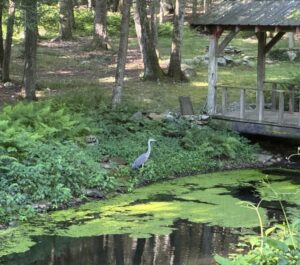
I gazed into the pond, suddenly silent of the frog chorus, to find a great blue heron motionless on a hunt.
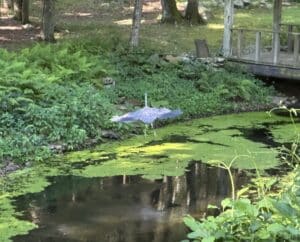
The great blue heron flies off, his wingspan like a kite flying above the footbridge.
As the sky began to light up, I lingered on the futon, enjoying the morning croaks of the green frogs, awaiting the rising sun to illuminate my eyelids. However, the angle has shifted, and the momma tulip tree now blocks the early morning rays. I adore that tree and her offspring to the right of the porch. As I rose, as if on cue, a light breeze kicked in, and the lovely lime-colored leaves danced in a whirling pattern as if to say hello.
I gazed into the pond, suddenly silent of the frog chorus, to find a great blue heron (Ardea herodias) motionless on a hunt. Their hearing, combined with extraordinary eyesight, makes them sensitive to disturbances. I tiptoed to the sliding glass door to retrieve my camera and was able to snag a few shots. Then watched him dive into the pond and resurface. To my happiness, no green frog was in his beak. Frogs plunge deeper into the water when they feel threatened.
The great blue heron flew off, its wingspan like a kite flying above the footbridge as I stood in awe. May we all pause in gratitude and wonder at the gifts of nature that surround us. And allow them just to be.
Garden Dilemmas? AskMaryStone@gmail.com and your favorite podcast app.
There’s more to the story in the Garden Dilemmas Podcast:
About Blaine Rothauser, Natural History Photographer, whose magnificent images are available to decorate your world.
Related Podcasts and Posts You’ll Enjoy:
Ep 116. Great Horned Owl meets Hawk
Great-Horned Owl meets Hawk – Blog Post
Ep 61. A Story of Treasured Tuliptrees
Treasured Tuliptrees – Blog Post

Jolee finds the remnants of a Red-shouldered Hawk
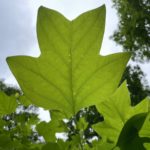
Tuliptrees get their name from their tulip-shaped leaves and flowers


